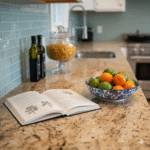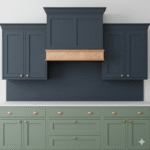
Why Kitchen Design Matters
The kitchen isn’t just a room where we cook—it’s the heart of the home. Whether it’s making a quick breakfast before school or preparing a big Sunday dinner, the kitchen plays a role in almost every part of daily life. That’s why kitchen design and organization are so important, they shape not only how a kitchen looks, but also how it feels and functions.
A well-designed kitchen can make cooking easier, reduce stress, and even bring joy to everyday tasks. On the other hand, a messy or poorly planned kitchen can be frustrating, no matter how big or beautiful it is.
Imagine trying to cook spaghetti and not knowing where the colander is, or having to dig through piles of pots just to find a pan. Frustrating, right? That’s where good organization comes in. When everything has its place, cooking becomes smoother, faster, and way more enjoyable.
So, whether you’re planning a full kitchen remodel, updating a few features, or just looking to organize what you already have, this guide will walk you through everything step by step. From layouts and storage to lighting and décor, we’ll cover all the tips you need to create a kitchen that’s both beautiful and practical.
Understanding the Basics of Kitchen Layouts
Before you start picking out cabinets or choosing paint colors, it’s important to understand how your kitchen layout works. The layout is like the “skeleton” of your kitchen—it affects how you move, cook, and clean every single day.
The Work Triangle Concept
One of the golden rules of kitchen design is the work triangle. This idea connects the three most important areas in the kitchen:
These are the spots you use most while cooking. Ideally, they should form a triangle shape that’s easy to move between. If they’re too far apart, you waste time walking. If they’re too close, you feel cramped. A balanced triangle saves time and effort, making cooking more enjoyable.
Popular Kitchen Layouts
There are a few common kitchen layouts, each with its own strengths:
- L-Shaped Kitchen: Great for open spaces and provides lots of counter space.
- U-Shaped Kitchen: Offers plenty of storage and work areas, ideal for big families.
- Galley Kitchen: Long and narrow, perfect for small spaces. Everything is close by, but it can feel tight.
- Island Kitchen: Adds extra counter and storage space in the center. Great for entertaining or having family help with cooking.
Choosing the Right Layout for Your Space
Your choice depends on two things: the size of your kitchen and your lifestyle. If you love cooking big meals, you’ll need lots of counter space. If you have a small apartment, a galley layout might be best. If you often have friends over, an island layout is a winner.
Remember: the goal is function first, style second. A beautiful kitchen that’s hard to use won’t make you happy in the long run.
Smart Storage Solutions for Every Kitchen
No matter how big or small your kitchen is, storage is always a challenge. Between pots, pans, spices, and snacks, things pile up quickly. The trick is using your space smartly so everything has a home.
Cabinets vs. Open Shelving
Cabinets are classic because they keep things hidden and tidy. But open shelves have become trendy; they let you display pretty dishes or glass jars and make the space feel open. The downside? They can look messy if not styled well. A good balance is mixing both, cabinets for the “not-so-pretty” stuff and open shelves for display.
Pull-Out Drawers and Organizers
Instead of digging through deep cabinets, pull-out drawers make life easier. You can install organizers for spices, utensils, or even garbage bins. This way, everything slides out smoothly, and you can see it all at once—no more playing hide-and-seek with your kitchen tools.
Maximizing Vertical and Hidden Spaces
Don’t just think sideways—think upward! Tall cabinets that reach the ceiling give extra storage for items you don’t use daily. Even the space under your sink or corners can be optimized with racks or rotating shelves. Hidden pull-out racks for cutting boards or towel holders also save space while keeping things neat.
Smart storage turns chaos into calm. Once you organize well, you’ll wonder how you ever managed without it.
Choosing the Right Materials and Finishes
The materials you choose for your kitchen affect not only how it looks but also how long it lasts. A kitchen is a “high-traffic zone”—it gets spills, scratches, and lots of use. Picking durable yet stylish finishes will save you money and headaches later.
Countertops
Countertops face the most action—chopping, hot pans, spills, you name it. Popular options include:
- Granite: Strong, natural, and beautiful. Each slab is unique.
- Quartz: Low maintenance and resistant to stains.
- Laminate: Budget-friendly but less durable.
- Butcher Block (Wood): Warm and cozy look, but needs care.
Flooring Options
Kitchen floors need to handle spills, drops, and heavy foot traffic. Common choices:
- Tile: Durable and water-resistant, but can feel cold.
- Vinyl: Affordable, waterproof, and softer underfoot.
- Hardwood: Beautiful but requires maintenance to avoid water damage.
Backsplash Ideas
The backsplash is both practical and stylish, it protects the wall from splashes while adding personality. Options range from classic subway tiles to colorful mosaics or even peel-and-stick tiles for budget makeovers.
Think of materials and finishes as the “wardrobe” of your kitchen. They dress it up while keeping it functional.
Kitchen Lighting, Brightening Up Your Space
Lighting can completely change the mood and usability of your kitchen. Too dim, and cooking feels like a chore. Too harsh, and it feels uncomfortable. The key is layering three types of lighting.
Task Lighting for Cooking
This is the practical stuff. You need bright light where you chop, cook, and clean. Under-cabinet lighting or pendant lights over the island are perfect for this.
Ambient Lighting for Comfort
This is the general light that fills the whole room. Ceiling lights or recessed lights are common choices. Warm-toned bulbs make the space cozy, while cooler tones feel more modern.
Accent Lighting for Style
Want to highlight a pretty backsplash or display shelf? Accent lighting adds personality. LED strips, glass cabinet lighting, or even a stylish chandelier can make your kitchen stand out.
The right mix of lighting doesn’t just make cooking easier—it also makes the kitchen a place where you’ll actually want to hang out.
Perfect colors set the mood of your kitchen more than anything else. A simple coat of paint or a carefully chosen palette can make the space feel bigger, warmer, or more modern. The great thing about kitchen color design is that it doesn’t have to be complicated, even small changes can make a big impact.
Classic White Kitchens
White kitchens never go out of style. They feel clean, bright, and timeless. White cabinets with light countertops create a fresh look, and you can always add color through accessories like rugs, curtains, or appliances. The best part? White makes small kitchens look larger by reflecting more light.
Fact: white can sometimes feel too plain or even clinical. That’s why many people pair it with textures like wood, stone, or metal to add warmth and contrast.
Bold and Colorful Options
If you want your kitchen to stand out, go bold! Deep blues, forest greens, or even a splash of yellow can make the space fun and inviting. Painted cabinets or a colorful backsplash are great ways to add personality without overwhelming the room.
Think of it like clothing—sometimes you wear classic black, but other times, you want a pop of color to show off your style.
Natural and Earthy Tones
For a cozy, calming vibe, earthy tones like beige, taupe, and soft greens are perfect. They create a warm, welcoming feel that makes the kitchen more inviting. Pairing natural wood with stone countertops or woven baskets adds texture and balance.
No matter what colors you choose, the secret is balance. Too much bold color can feel chaotic, and too much neutral can feel dull. The sweet spot is mixing shades that reflect your personality while keeping harmony in the space.
Budget-friendly doesn’t mean cheap—it means smart spending where it matters most.
Organizing Your Pantry
A messy pantry is every cook’s nightmare. You open the door and—bam!—cereal boxes, snack bags, and spice jars come tumbling out. Organizing your pantry not only saves time but also saves money because you’ll stop buying duplicates of items you already have.
Clear Containers vs. Original Packaging
Clear containers are a game-changer. Instead of having ten half-empty pasta boxes, you can pour everything into transparent jars. Not only does it look neat, but it also lets you see how much you have left at a glance. Dry goods like rice, beans, flour, and snacks fit perfectly in airtight containers, keeping them fresher for longer.
Labeling Systems
Labels are your pantry’s best friend. You don’t need anything fancy, a marker and masking tape will do. But if you want to take it up a notch, printed or chalkboard labels look stylish and make things easier to find.
Keeping Track of Expiration Dates
Food waste is a big problem in many homes, and expiration dates are usually to blame. One smart trick is to keep older items in front and new ones in the back, just like grocery stores do. You can also write expiration dates directly on jars or containers with a marker.
When your pantry is well-organized, cooking feels less stressful, and you’ll actually enjoy spending time in the kitchen.
Appliances, What Fits Your Lifestyle
Appliances are the powerhouse of your kitchen. From your refrigerator to your blender, they affect how smoothly your daily routine goes. But here’s the thing—more appliances don’t always mean better. The key is choosing what you actually need.
Essential Appliances Every Kitchen Needs
At the very least, every kitchen should have:
- A refrigerator
- A stove or cooktop
- An oven
- A microwave
- A dishwasher (optional, but a time-saver)
These basics cover most cooking and cleaning tasks.
Space-Saving Appliances for Small Kitchens
If you have a small kitchen, you’ll want to think smarter. Compact appliances like a slim dishwasher, countertop ovens, or even two-in-one washer-dryer units (in apartments) can save tons of space.
Smart Kitchen Technology
The future is here—smart fridges that tell you when food is about to expire, ovens you can control with your phone, and even voice-controlled assistants to help with recipes. While these aren’t must-haves, they can make life easier if you love tech.
When buying appliances, think about your cooking habits. If you don’t bake, don’t waste money on a fancy oven. If you meal-prep often, a big fridge might be your best investment. The right appliances should fit your lifestyle, not the other way around.
Small Kitchen Design Ideas That Make a Big Impact
Not everyone has a huge, open kitchen—and that’s okay. With smart design tricks, even the tiniest kitchen can feel spacious and stylish.
Multipurpose Furniture
Furniture that serves more than one purpose is a lifesaver in small kitchens. A kitchen island with built-in storage, a fold-out dining table, or stools that tuck neatly under the counter can save space without sacrificing function.
Foldable and Extendable Options
Think about collapsible furniture—folding chairs, pull-out cutting boards, or extendable counters. These allow you to expand your workspace when needed and tuck it away when you’re done.
Using Mirrors and Light for Space Illusion
Here’s a designer trick: mirrors and reflective surfaces make small spaces look bigger. Glossy cabinets, glass doors, and light colors reflect light and create an airy feel. Add good lighting, and your tiny kitchen will suddenly feel more open.
A small kitchen doesn’t have to be a limitation. With the right choices, it can be cozy, efficient, and even stylish.
Eco-Friendly Kitchen Design
Sustainability isn’t just a trend—it’s a responsibility. The kitchen is one of the best places to start living greener. From the appliances you buy to the way you store food, every choice makes a difference.
Energy-Efficient Appliances
Modern appliances often come with an energy star rating, which means they use less electricity and water. This saves you money on bills while helping the planet. For example, an energy-efficient dishwasher can use less water than hand washing.
Sustainable Materials
Choosing materials like bamboo, recycled wood, or eco-friendly countertops (like recycled glass or paper-based options) reduces your environmental footprint. Plus, they look unique and stylish.
Reducing Food and Plastic Waste
Small habits make a big impact. Using reusable grocery bags, glass containers instead of plastic, and composting food scraps can cut down household waste dramatically. You’ll feel good knowing you’re reducing your impact on the environment.
An eco-friendly kitchen is not just about saving the planet—it’s also about creating a healthier home for you and your family.
Creating a Cooking Workflow That Works
A kitchen isn’t just about looks—it’s a working space. The way you set it up can either make cooking smooth and stress-free or turn it into a daily struggle. That’s why creating an efficient workflow is key.
Zoning Your Kitchen (Prep, Cooking, Cleaning)
Think of your kitchen in zones. Each zone has its own purpose:
- Prep Zone: Where you chop, mix, and get food ready. This area should have cutting boards, knives, and mixing bowls within reach.
- Cooking Zone: The stove, oven, and all your pots and pans live here. Keep spatulas, spoons, and spices close by so you’re not running around while food is on the burner.
- Cleaning Zone: This is around the sink and dishwasher. Sponges, soaps, and towels should all be nearby for quick cleanups.
When everything is grouped by zone, cooking feels like moving through a smooth assembly line.
Keeping Tools Where You Need Them
Ever notice how annoying it is when you can’t find the right tool at the right time? The secret is storing items where they’re used. For example, keep baking sheets near the oven, knives near the prep area, and cups near the fridge. It may sound simple, but it saves a lot of unnecessary steps.
Making Cooking Stress-Free
Cooking should feel fun, not frustrating. That’s why decluttering is just as important as organizing. Too many gadgets or random items crowding your counters will make the space feel chaotic. Keep only what you actually use and donate the rest..
With a good workflow, you’ll feel like your kitchen is working with you, not against you.
Kitchen Safety and Ergonomics
A kitchen is full of potential hazards—sharp knives, hot surfaces, and heavy pans. But with smart design and organization, you can make it a safe and comfortable place for everyone in the family.
Childproofing Tips
If you have kids, safety becomes even more important. Some simple steps include:
- Installing cabinet locks for cleaning supplies.
- Using stove knob covers so little hands can’t turn on burners.
- Keeping sharp objects in drawers with safety locks.
A safe kitchen means peace of mind.
Fire Safety Essentials
Since the kitchen is where most house fires start, it’s smart to be prepared. A fire extinguisher should always be within reach, and you should know how to use it. Also, never place dish towels or paper near the stove—they can catch fire quickly.
Designing with Comfort in Mind
- Ergonomics simply means designing for comfort and efficiency. For example, placing the oven at eye level prevents bending, and drawers are often easier on the back than deep cabinets.
- Good lighting also reduces eye strain while cooking.
- A kitchen should feel safe and comfortable.
- Personal Touches That Make a Kitchen Feel Like Home
Family Photos and Art
Adding photos, small artworks, or even a chalkboard wall for notes gives the kitchen personality. It reminds you that this is a family space, not just a cooking station.
Plants and Greenery
Plants breathe life into any room, and the kitchen is no different. Herbs like basil, mint, or rosemary are not only decorative but also useful in cooking. Small succulents or hanging plants can also brighten the space.
DIY Decorative Touches
Homemade touches like painted jars, handwoven baskets, or open shelves styled with favorite mugs make the kitchen truly yours. It’s like putting your signature on the space. At the end of the day, these little details are what transform a house into a home.
Budget-Friendly Kitchen Design Tips
Redesigning or organizing your kitchen doesn’t have to cost a fortune. With some clever tricks, you can make big improvements without draining your wallet.
Affordable Upgrades with Big Impact
Sometimes, small updates make the biggest difference. Painting cabinets, changing handles, or adding peel-and-stick backsplash tiles can instantly refresh the look without a full renovation. Even swapping old light fixtures for modern ones can transform the mood.
When to Splurge and When to Save
Not everything needs to be top-of-the-line. Spend more on things you’ll use daily, like countertops, appliances, and flooring, since they take the most wear and tear. Save money on decorative items, shelving, or secondary appliances you don’t use often.
DIY vs. Professional Help
DIY projects like painting, installing shelves, or organizing are great for saving money. But for plumbing, electrical work, or major installations, hiring a professional is worth it. Mistakes in these areas can cost more to fix than doing it right the first time.




